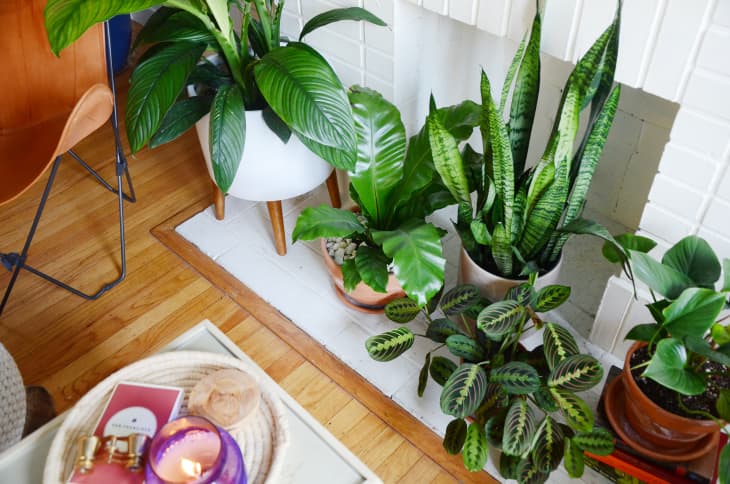If you’ve ever drowned a houseplant, you’re not alone. Even experienced plant parents get a little heavy handed with the watering can sometimes, and unfortunately that can be a death sentence for many species. But don’t worry—there are some plants that actually want soil that never dries out.
Planting and watering notes
For plants that tolerate, and even welcome, an overabundance of water, it’s still important to plant them in well-draining potting soil in a pot with drainage holes to prevent the soil from becoming waterlogged. Terracotta pots are an excellent choice because they allow water to evaporate through the porous clay. You might also see wet patches on the pot where the clay has soaked up excess water. This is a sign to hold off a day or two before watering again.
With the exception of cyperus, the plants below all prefer soil to be consistently and evenly damp, though not sopping wet. It’s best to test the soil daily with your finger to see if it shows signs of drying out before watering again.
Baby’s Tears
Baby’s tears (Helxine soleirolii) is a bright green creeping plant with tiny little teardrop shaped leaves. These plants are often used in terrariums because they love moisture and form a dense carpet of foliage over the soil. When planted in a pot, the vines trail down the sides, making baby’s tears an excellent choice for small hanging planters. Keep the soil constantly moist and remember to pinch back vines frequently to prevent legginess.
Cyperus
If your houseplants repeatedly succumb to root rot, get yourself a cyperus. Cyperus plants have tall grass-like shoots topped with slender bracts that droop downward in an umbrella shape. Cyperus are natives of tropical swamps, so it’s virtually impossible to overwater them. The soil must be kept constantly damp and some varieties will survive standing water. These plants also prefer high humidity, so mist daily. There are many varieties of cyperus, but Cyperus albostriatus and Cyperus alternifolius ‘Variegatus’ are both popular and easy to find.
Selaginella
Moisture-loving selaginellas are another great choice for terrariums. These low-growing plants come in dozens of varieties and have a prehistoric lineage linked to the fern family. They’re often used as ground covers, but they make attractive indoor plants and look nice in hanging baskets. Soil should be kept damp at all times and the plant needs to be misted frequently. There are many varieties of selaginellas with distinctive appearances—Selaginella kraussiana ‘Aurea’ has light green feathery foliage and is widely available.
Boston fern
Boston ferns (Nephrolepis exaltata) have upright shamrock-green fronds that droop gracefully. Most ferns do well in damp environments that mimic their native forest floor habitat, and this classic houseplant is very easy to grow provided you never allow the roots to dry out. The leaves will turn yellow if there is not enough humidity in the room, so mist the plant daily or keep the pot in a shallow saucer of water.
Pitcher plant
Pitcher plants (Saccacenia) are carnivorous plants with leaves that form long tubes to trap insects. They grow natively in bogs, so they like soil that is constantly wet. However, you should only give pitcher plants distilled water or rainwater. They are accustomed to nutrient-poor soils and the minerals found in spring and tap water may build up in the soil and cause the plant to deteriorate. For best results, keep your pitcher plant in a tray filled with an inch of water to keep the roots wet at all times, watering from the top only occasionally.
Hải Yến
Gió bạn với cây tự buổi nào ,
Gió về cây lại ngất ngư chao .
Gió đi cây sẽ im lìm đứng,
Như kẻ lỡ làng dạ khát khao .
Hải Yến
Gió bạn với cây tự buổi nào , Gió về cây lại ngất ngư chao . Gió đi cây sẽ im lìm đứng, Như kẻ lỡ làng dạ khát khao .



